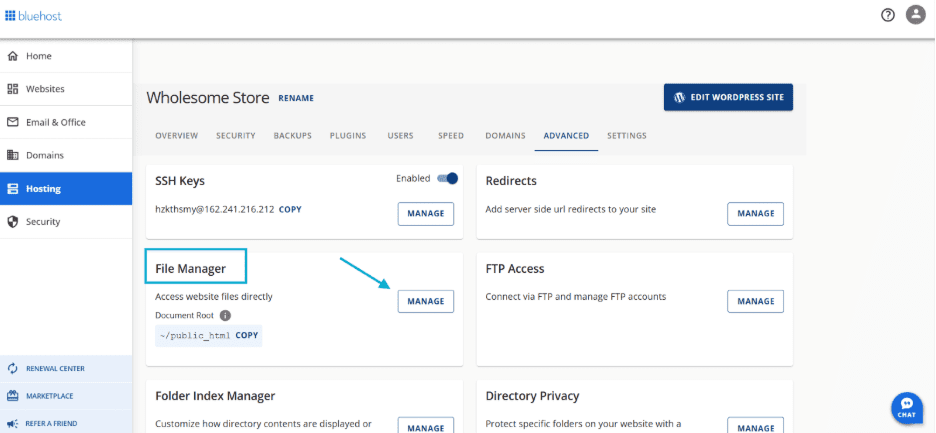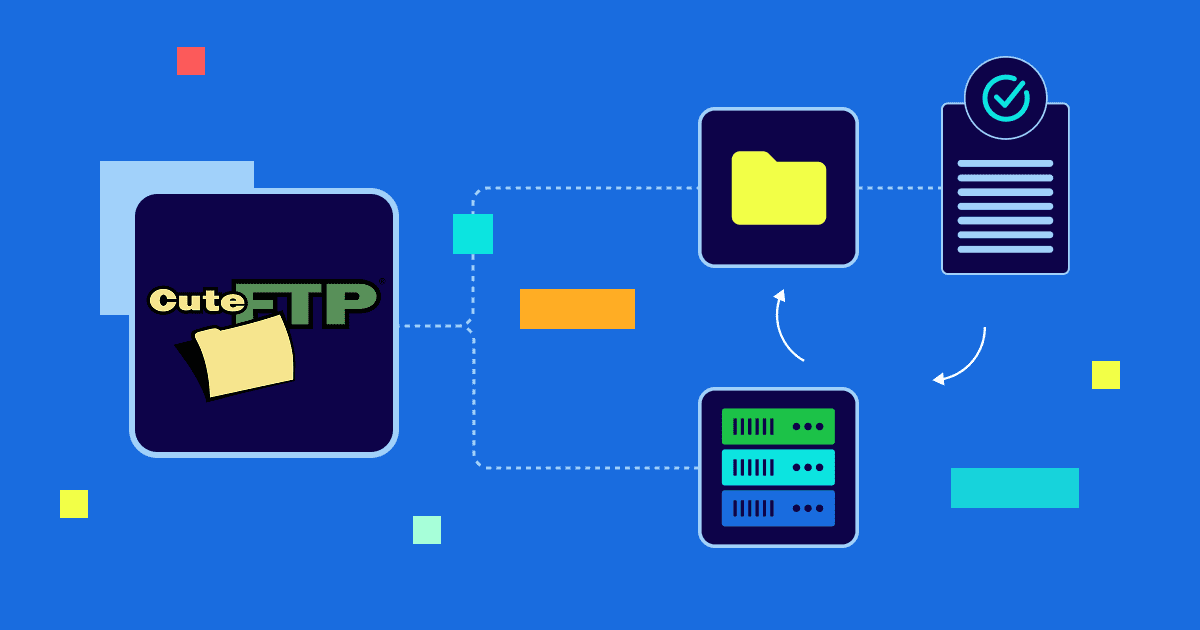Key highlights
- Understand what configuration files are and how they control settings for websites and computer programs.
- Learn to write and manage config files for better performance and security.
- Explore configuration file management techniques to simplify setup and troubleshooting.
- Compare text and binary formats used in different configuration files.
- Discover how Bluehost simplifies configuration file management with diverse tools and automated backups.
Have you ever wondered what configuration files are? Every time you update a website setting, fix an error or migrate your site, you work with one.
These simple text files control how your system runs. They define database connections, user access, color schemes and other settings that keep your software running smoothly.
In this guide, you’ll explore configuration file management, learn how configuration files work, discover common formats and find best practices to keep them secure.
What are configuration files?
A configuration file is a simple text file that stores important configuration settings and parameters for your website, application or software system.
It defines how your program should run by including details like database connections, server paths, caching preferences and environment variables.
These individual configuration files give every software instance its own setup, which is especially useful when working with different environments such as development, testing and production.
For example:
- In WordPress, the wp-config.php file defines how your site connects to the database.
- In Magento, the env.php file manages caching and session settings.
- In Laravel, the .env file handles environment variables and app mode.
Also read: Configuring File Permissions in File Manager: A Step-by-Step Guide
Anatomy of a configuration file
Even though configuration files come in different file formats, most share a similar structure. Once you understand the basics, reading or editing them becomes easy, no matter which software or operating system you’re using.

Most configuration files are written in plain text formats like INI, YAML or JSON. They usually contain key-value pairs that define specific configuration options, along with comments and section headers to keep things organized.
Let’s break it down:
1. Basic structure and components
Every configuration file starts with a simple, readable layout. The file may include a few comments for context, followed by key-value pairs that store your app’s settings.
Example (app.conf):
# Application Settings
max_connections=200
debug_mode=true In this example, each key (like max_connections) is linked to a specific value (200). Together, a key-value pair consists of one setting instruction that tells the program how to behave.
2. Key-value pairs
A key-value pair is the simplest and most common configuration structure. You can edit these easily using a text editor.
Example:
PORT=8080
ENVIRONMENT=production This format is widely used because it’s easy to read, modify and share between different environments or multiple servers.
3. Sections, headers and hierarchy
Some configuration files use structured sections to organize settings for better readability. The INI file format and YAML files are great examples of this approach.
INI Example:
[database]
host=localhost
user=root
password=secret
YAML Example:
For detailed instructions, see Accessing the File Manager.
database:
host: localhost
port: 5432 Each section or configuration block groups related parameters, which helps you quickly locate and update specific settings.
4. Comments and annotations
Lines starting with “ # ” or “ ; ” are called comments. They don’t affect the program’s syntax, but they’re extremely helpful for documentation and teamwork.
Adding notes about what a particular setting does makes your configuration file management more sustainable and less prone to security risks or mistakes.
Understanding the basic structure of configuration files helps you edit, customize and maintain them more confidently.
Whether you’re using JSON, INI or YAML, the goal remains the same: to define your configuration data in a clear, consistent and secure way.
What are the benefits of using configuration files?
Using configuration files offers more than just convenience. They help developers, system administrators and even everyday users manage settings efficiently while keeping the source code clean and flexible.

Whether you’re running a small website or multiple servers, good configuration file management ensures everything stays organized, secure and easy to maintain.
Once you understand what configuration files are, it becomes easier to see how they improve flexibility and simplify scaling. Let’s look at some of the biggest advantages.
1. Separation of code and configuration
A major benefit of using configuration files is the clear separation between your code and your configuration data. You can change parameters such as database credentials, file paths or caching options without modifying the application’s core logic.
This makes updates safer and reduces the chance of breaking your site. On Bluehost, you can quickly adjust configuration settings using the Bluehost File Manager or a basic text editor.
2. Ease of deployment and scaling
When you work across different environments like development, staging or production, managing settings becomes easier with separate configuration files. Each environment can have its own config file that defines unique parameters and ensures smooth performance without affecting others.
If you’re hosting on multiple servers, you can deploy changes consistently by syncing these files across systems. Bluehost’s tools simplify this process, making configuration changes quick and reliable.
3. Portability and platform independence
Since most configuration files use plain text formats like JSON, INI or YAML, they’re portable and compatible with many operating systems. You can easily move them between servers or even to a different hosting provider without losing critical configuration options.
This flexibility saves time during migrations and reduces setup errors, which is especially helpful when managing many programs or shared hosting environments.
4. Improved security and reliability
Good configuration file management also reduces security risks. By controlling file permissions and separating sensitive data from public directories, you lower the chance of unauthorized access.
On Bluehost, default permissions help protect your configuration files. Also, tools like the MultiPHP INI Editor let you safely adjust PHP settings. Plus, automatic backups include these files, keeping your configurations secure and recoverable.
Also read: How to Edit the PHP INI Settings
What are the different types of configuration files?
Different types of configuration files vary based on their file format and structure. These files define how a software system, application or operating system should behave, allowing you to customize settings without altering the source code.
Each format organizes data differently and the choice often depends on the framework or environment you’re using.

Some formats are simple and human-readable, while others are structured for handling complex configuration options.
Let’s explore the most common types of configuration files and how developers use them in real projects.
1. Plain text files
Older web servers and applications like Apache or Nginx use simple text files for their configuration. These files use straightforward syntax that’s easy to read and edit.
Example (nginx.conf):
server {
listen 80;
server_name example.com;
root /var/www/html;
} Plain text formats are flexible and can be edited in any text editor, making them accessible to both beginners and experienced developers.
2. JSON files
JavaScript Object Notation (JSON) is a lightweight file format that’s popular for modern web applications. It’s easy to read and integrates well with many programming languages.
Example:
{
"siteName": "BluehostDemo",
"debug": true,
"port": 8080
} Because JSON is both human- and machine-readable, many programmers prefer it for managing configuration data in scalable projects.
3. XML files
XML files (Extensible Markup Language) are common in enterprise software, .NET applications and Java-based systems. They use a tag-based markup language that supports hierarchical configuration sections.
Example:
<configuration>
<appSettings>
<add key="SiteName" value="BluehostDemo"/>
<add key="Theme" value="Light"/>
</appSettings>
</configuration> While XML can look complex, it’s extremely powerful for structured configuration file management.
4. INI files
The INI file format is one of the simplest ways to define configuration settings. It uses sections and key-value pairs to organize options clearly.
Example:
[app]
theme=light
notifications=enabled INI files remain popular because they’re easy to maintain and work well across different environments.
5. ENV files
An ENV file is used to define environment variables that control how a program runs. You’ll see these in frameworks like Laravel, Node.js and Django.
Example:
DB_HOST=localhost
DB_USER=admin
DB_PASS=secret Since ENV files store sensitive configuration data, always keep them outside public directories to reduce security risks.
6. YAML files
A YAML file (Yet Another Markup Language) is widely used in DevOps tools and cloud configurations. It’s known for its clean syntax and support for multiple configuration files.
Example:
app:
name: BluehostDemo
version: 1.2
database:
host: localhost
port: 3306 YAML is favored for its readability and compatibility with automation tools like Docker and Ansible.
What are the best practices for configuration file management?
Strong configuration habits keep your applications stable, secure and easy to maintain. By managing configuration files carefully, you can streamline updates, prevent errors and ensure consistency across different environments.
Let’s look at a few best practices that make configuration file management more efficient and reliable.
1. Keep sensitive data secure
Always protect credentials like database passwords or API keys stored inside your config files. Instead of saving them directly in plain text, use environment variables or encrypted values.
Also, store configuration files in a private folder outside the public web root. On most operating systems, you can easily restrict permissions or define security rules within your config directory to prevent unauthorized access.
2. Maintain a consistent naming convention
When working with multiple configuration files, consistent naming helps you and your team locate files quickly. Use clear names that indicate the file’s purpose for example, database.conf or email-settings.cfg.
This approach makes it easy to identify each file’s function and prevents confusion when new components are added to your system.
3. Use version control
Treat your configuration files like part of your project code. Using tools like Git allows you to write, track and revert changes as needed.
This helps when testing updates or managing configurations across different environments. It also ensures you always have a history of previous setups in case something goes wrong.
4. Regularly back up configuration files
Before making any updates, create a backup of your own configuration file or the entire config directory. It’s a simple but crucial step that helps you recover quickly if a config change breaks something or if an error occurs during deployment.
Bluehost users can automate this with built-in backup tools, ensuring that your system always has a safe restore point.
5. Use configuration management systems
Many developers use specialized tools like Ansible, Chef or Puppet to automate config file deployment and updates. These tools help you configure and manage separate files across different servers with minimal effort.
Such systems ensure that every instance of your application uses the same configuration syntax and values, which is vital for maintaining consistency and performance.
When you create a new configuration setup, remember clarity, security and consistency always pay off. The simplest form of organization can save hours of debugging later.
Where are configuration files located?
Knowing where configuration files live can save you hours when troubleshooting, migrating or optimizing your website.
| Script name | Location of configuration file |
| 4Images Gallery | /config.php |
| B2 Evolution | /conf/_basic_config.php |
| Boonex Dolphin | /inc/header.inc.php |
| Concrete5 | /application/config/database.php |
| Coppermine Photo Gallery | /include/config.inc.php |
| Crafty Syntax Live Help | /config.php |
| Cube Cart | /includes/global.inc.php |
| dotProject | /includes/config.php |
| Drupal | /sites/default/settings.php |
| e107 | /e107_config.php |
| FAQMasterFlex | /faq_config.php |
| Gallery | /config.php |
| Geeklog | /db-config.php or /siteconfig.php or /lib-common.php |
| glfusion | /private/db-config.php |
| Hotaru | /hotaru_settings.php |
| Joomla | /configuration.php |
| LiveSite | /livesite/config.php |
| LifeType | /config/config.properties.php |
| Magento | /app/etc/env.php |
| Mambo | /configuration.php |
| Marketecture | /include/config.php |
| MODx | /manager/includes/config.inc.php |
| Moodle | /config.php |
| MyBB | /inc/config.php |
| Noahs Classifieds | /app/config.php |
| Nucleus | /config.php |
| ocPortal | /info.php |
| OpenCart | /config.php or /admin/config.php |
| osCommerce | /includes/configure.php or /admin/includes/configure.php |
| Oxwall | /ow_includes/config.php |
| PHP-Nuke | /config.php |
| phpBB | /config.php |
| phpFormGenerator | /index.php or /mysql.class.php |
| phpFreeChat | /forms/admin/config.inc.php (only if you have saved form input to a database) |
| PHPlist | /config/config.php |
| phpMyDirectory | /defaults.php |
| phpWCMS | /include/inc_conf/conf.inc.php |
| phpWebSite | /conf/config.php |
| PhpWiki | /admin.php or /lib/config.php |
| Pligg | /libs/dbconnect.php |
| Post-Nuke | /config.php |
| PrestaShop | /config/settings.inc.php |
| Saurus CMS | /config.php |
| ShopSite | /includes/configure.php or /admin/includes/configure.php |
| Siteframe | /config.php |
| Simple Machines Forum | /Settings.php |
| Soholaunch | /sohoadmin/config/isp.conf.php |
| SugarCRM | /config.php |
| Textpattern | /textpattern/config.php |
| TikiWiki | /db/local.php |
| Tomato Cart | /includes/configure.php |
| Trendy Site Builder | (does not use DB) |
| TYPO3 | /typo3conf/localconf.php |
| vBulletin | /includes/config.php |
| WebCalendar | /includes/settings.php |
| WHMCS | /configuration.php |
| WordPress | /wp-config.php |
| X7 Chat | /config.php |
| Xoops | /mainfile.php |
| Zen Cart | /includes/configure.php or /admin/includes/configure.php |
| Zen Photo | zp-data/zenphoto.cfg |
| Zikula | /config.php |
How Bluehost simplifies configuration management?
Bluehost makes configuration file management easy, even for users without deep technical knowledge.
Here’s how:
- Easy Bluehost file manager access: Open, edit and organize configuration files directly from Bluehost account manager; no command line required.

- PHP tools: The MultiPHP INI Editor lets you adjust PHP settings quickly.
- Automated backups: Bluehost automatically includes configuration files in its backup process, making recovery effortless.
- Built-in security: File permissions and access controls are applied automatically to protect sensitive data.
- Expert support: Bluehost’s 24/7 chat support team can guide you through locating and managing these files safely.
Take full control of your website setup today. Start managing your configuration files easily with Bluehost hosting, your reliable partner.
Final thoughts
Strong configuration management keeps your system running smoothly and prevents common errors. When you understand how to locate, edit and back up each config file, you gain full control over your website’s performance and security.
With Bluehost, managing configuration becomes simple. You can easily create, configure and test settings through a clean user interface, no coding expertise required.
From adjusting key components to handling backups or testing environments, Bluehost gives you all the tools to manage configuration files with confidence and ease.
FAQs
The five pillars are identification, control, status accounting, verification and documentation. Together, these practices help you configure and maintain consistent settings across your system ensuring stability and easier troubleshooting.
The storage of the configuration files depends on your platform or operating system. For example, WordPress keeps its config file (wp-config.php) in the /public_html/ folder, while Laravel stores the .env file inside /home/username/project/.
Each instance may use a different file extension or directory structure, so always check your hosting dashboard or cPanel.
Begin by locating your own configuration files, then back them up and review their syntax. Use version control for tracking changes and avoid storing sensitive data in public directories. Bluehost makes this easy with tools for editing, testing and restoring files directly through its user interface.
Examples include wp-config.php for WordPress, .env for Laravel or php.ini for PHP settings. These config files define crucial parameters like database credentials, caching preferences and email setup helping many developers manage and create stable environments efficiently.
.env stores environment variables; config.php contains runtime configuration. .env is often used in frameworks like Laravel, while config.php is typical in CMS platforms like WordPress or Joomla.
Yes, but always back up the file first and avoid modifying critical paths unless you’re sure of the impact.
Use the built-in File Manager in your Bluehost dashboard or connect via FTP. For PHP settings, use the MultiPHP INI Editor.




Write A Comment